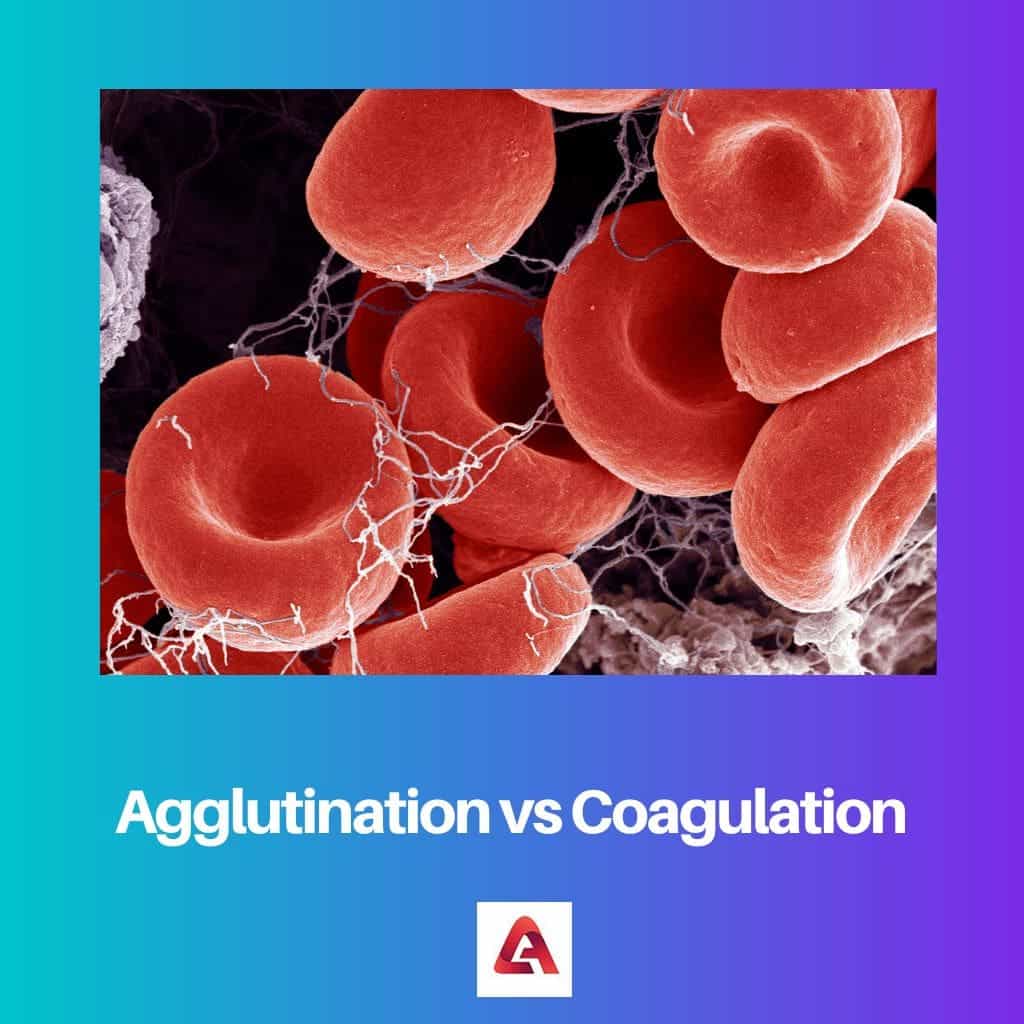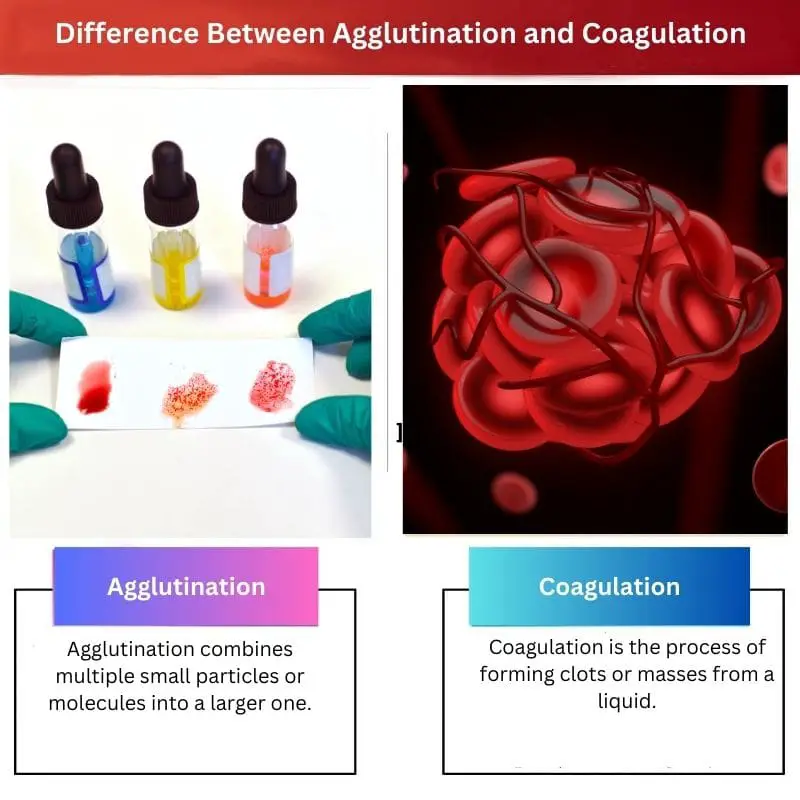Agglutination is a term used in biology to describe the process whereby a large molecule, such as a protein or DNA, is broken down into smaller pieces.
The smaller pieces can then be absorbed by the body’s cells. Agglutination can also refer to the clumping together of red blood cells, which is an important part of the body’s immune system.
While coagulation is the process of blood clotting, this occurs when platelets in the blood clump together and form a plug to seal a wound.
The clotting process also involves releasing chemicals that constrict blood vessels and help form a stable clot.
Key Takeaways
- Agglutination is the clumping of particles, such as cells or bacteria, caused by the interaction of antigens and antibodies.
- Coagulation is the process of blood clotting involving a complex cascade of events that ultimately leads to forming of a solid clot.
- Both processes play vital roles in the immune system and hemostasis, but agglutination primarily involves immune responses, while coagulation focuses on preventing blood loss.

Agglutination vs Coagulation
Agglutination is the adhesion of substances, while coagulation refers to blood clot formation. Agglutination can occur with many particles, but the latter occurs only in blood. Antigen-antibody interaction causes agglutination, while different plasma factors cause coagulation.
Comparison Table
| Parameter of Comparison | Agglutination | Coagulation |
|---|---|---|
| Main Function | Clumping | Maintaining steady state |
| Disorders | Cold agglutinin disease | Hemophilia A, B & CFactor V LeidenProtein C & S deficiency |
| Risks | Severe anemia | Severe blood lossStroke |
| Treatments | Avoiding cold exposureArtificial antibodyBlood transfusionPlasma transfusion | Plasma transfusionVitamin KAnticoagulants |
What is Agglutination?
Agglutination is a process that occurs when a molecule of the antibody binds to a molecule of antigen. This process causes the formation of large, insoluble complexes called agglutinates.
The presence of agglutinates in the bloodstream can be diagnostic of certain diseases.
One common use of agglutination is in blood typing. In this procedure, blood is mixed with an antiserum that contains antibodies against specific blood types.
If the person’s blood contains the antigen against which the antibody is directed, clumping will occur. This clumping can be easily detected and used to determine the person’s blood type.
Agglutination can also detect bacteria and other microorganisms in a tissue or body fluid sample.
In this procedure, a suspension of the microorganisms is mixed with a serum that contains antibodies against them.
If the microorganisms are present, they will bind to the antibodies, and form agglutinates. These agglutinates can be easily detected and used to identify the organisms in the sample.
Agglutination can also be used to detect the presence of antibodies against certain antigens. When a serum containing antibodies is mixed with an antigen, clumping will occur if the antibody binds to the antigen.
This type of agglutination test can be used to diagnose infections, autoimmune diseases, and allergies.
The process of agglutination is important in medical diagnostics and research. It can detect the presence of antigens, antibodies, and microorganisms, making it a powerful tool for identifying the cause of a disease or infection.
Researchers and physicians can more accurately diagnose and treat patients by understanding the agglutination process.
What is Coagulation?
When a wound occurs, the body’s natural response is to begin the process of coagulation. This begins with the release of platelets from the damaged blood vessels.
The platelets and the exposed collagen in the tissue stick to each other, forming a plug that stops the bleeding.
The next step in coagulation is the activation of the clotting factors. The liver produces these proteins and circulates them in the blood.
They work together to form a fibrin mesh over the platelet plug. This mesh traps more platelets and other clotting factors, creating a stable clot.
If a blood vessel is severed, coagulation can occur very quickly, sometimes in just a few seconds. However, if there is only a minor tear, it may take several minutes for coagulation to occur.
In this case, the clotting process is slowed by the presence of anticoagulants. These proteins inhibit clot formation, providing increased protection for the damaged area.
The coagulation process helps to prevent further blood loss and protect the wound from infection. The fibrin mesh also serves as a scaffold for new tissue growth and wound healing.
Once the wound has healed, enzymes in the body break down the clot, allowing normal blood flow to resume. This process is known as fibrinolysis.
Coagulation is important in maintaining a healthy body and protecting it from injury and infection.
Minor cuts and scrapes could cause serious blood loss and dangerous health complications without this process.
By understanding how coagulation works, we can better protect ourselves and others from these risks.
Main Differences Between Agglutination and Coagulation
- Agglutination combines multiple small particles or molecules into a larger one, while coagulation is the process of forming clots or masses from a liquid.
- Agglutination occurs when smaller molecules are attracted to a surface, while coagulation occurs due to chemical or physical changes within the liquid.
- Agglutination is reversible, while coagulation is not.
- Agglutination results in a more stable structure than coagulation.
- Coagulation requires less energy than agglutination.
- Coagulation occurs faster than agglutination.
- Coagulated material is less soluble than aggregated material.
- Coagulated material is less deformable than aggregated material.

- https://repositorium.sdum.uminho.pt/handle/1822/31622
- https://biostor.org/pdfproxy.php?url=https%3A%2F%2Farchive.org%2Fdownload%2Fbiostor-54824%2Fbiostor-54824.pdf
